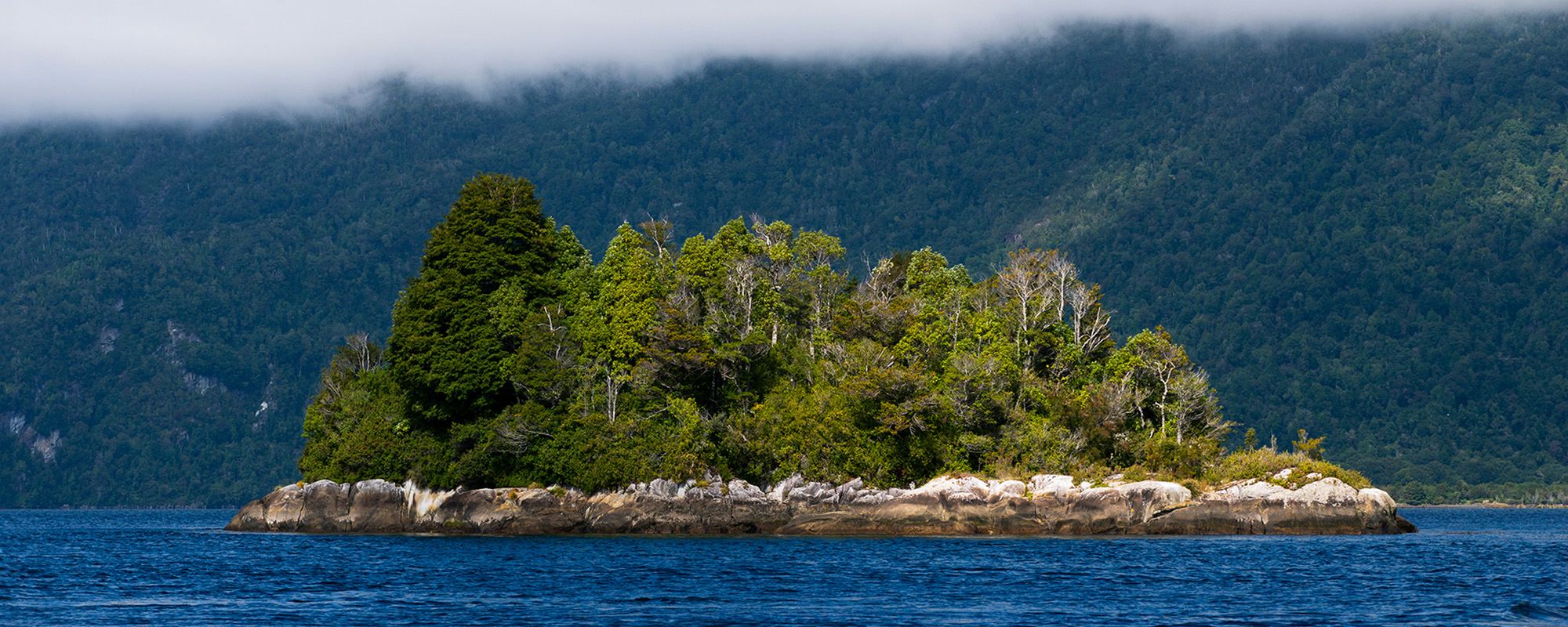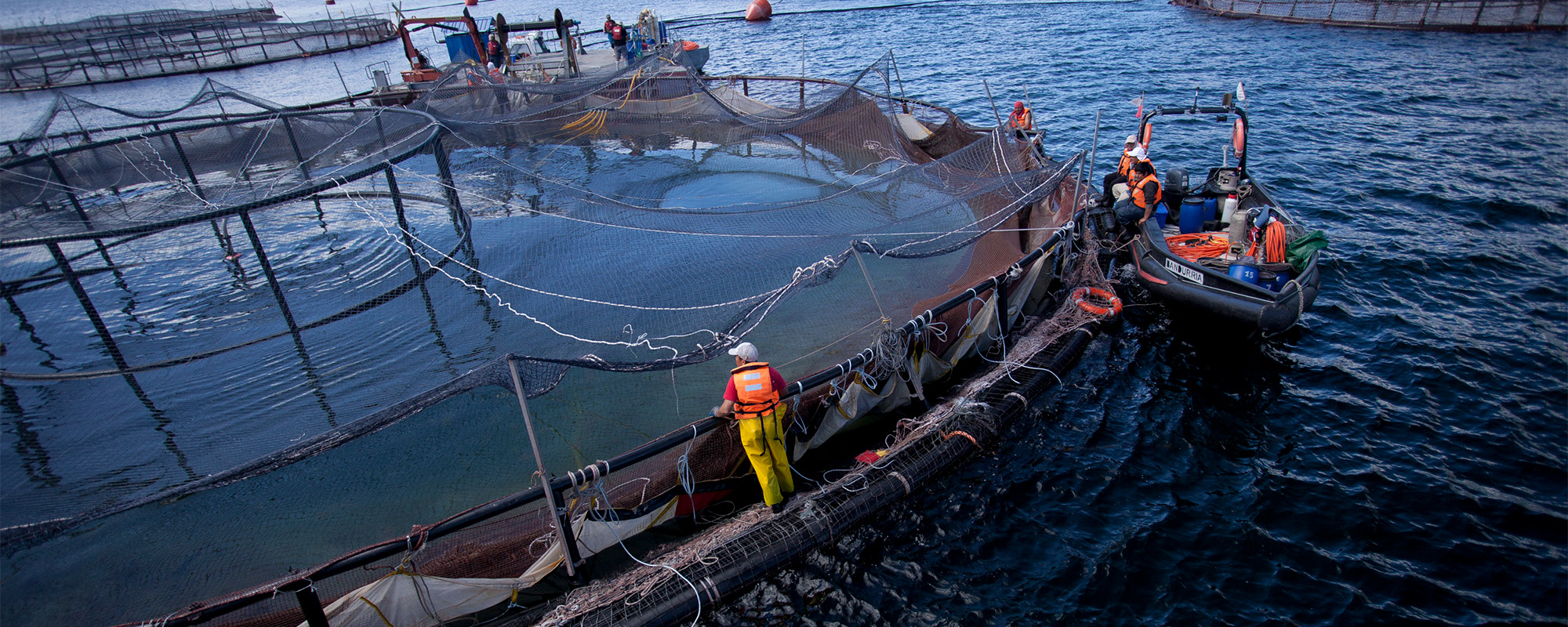
Photo: Eduardo Sorensen
The impact of the industry on ecosystems
There are more than 400 aquaculture concessions granted within protected areas of Patagonia. This figure represents 29% of the total concessions existing in Chile.
Since this involves the farming of exotic and carnivorous species, using an intensive production system,
it requires artificial food supply, therapeutic treatments, use of disinfectants, infrastructure for the development of cage farms, among
others, generating various environmental impacts.
Use of antibiotics
Salmon are affected by diseases in both freshwater and saltwater, which spread easily among them due to anoxia (lack of oxygen) in their waters and the overcrowding in which they are kept. Salmon diseases include bacterial kidney disease (BKD), piscirickettsiosis (SRS), rainbow trout fry syndrome (RTFS), and infectious pancreatic necrosis (IPN).
Antibiotics to treat bacterial diseases are mainly administered through two methods: medicated feed or injections.
One serious consequence of medicated feed is that when it is not consumed by salmon, it becomes part of the diet of native fish living near the cages, disrupting the food chain and ecosystem health, generating bacterial resistance, among other potential impacts.
This means that, in general, marine ecosystems are impacted because the antibiotics contaminate the waters and permeate the various native species surrounding the farming centers. There is no effective control or guarantee that native species ingest these antibiotics deposited on the seabed or dispersed by marine currents.
Pollution from the use of chemical products
In addition to antibiotics, the industry uses a large quantity of other chemical products, including disinfectants, antifoulants, and medicines such as anesthetics, antiparasitics, and vaccines. Some of these chemicals pose health and environmental risks due to the methods of administration and frequency applied by the industry, such as disinfectants, antifoulants, and antiparasitics.
The presence of these chemical products causes harm and involuntary consumption by species inhabiting these ecosystems, impacting their life cycles, potentially causing biodiversity loss, changes in microbial communities, and other possible damages.
Salmon escapes
Salmon are exotic species that severely alter native ecosystems because they directly prey on native freshwater and saltwater fauna, such as rockfish or “colde,” silversides, puyes, “mote,” among others. They also compete for food with native species that have similar prey, such as sea bass, rockfish or “colde,” “huaica,” icefish or lanternfish, “rollizo,” and “blanquillo.”
Between 2010 and 2020, a total of 69 escape events were reported, with 40 events in the Los Lagos region, 26 in Aysén, and 3 in Magallanes. This means that the total number of escaped fish was close to 5 million, of which only just over 600,000 were recaptured.
Currently, the General Fisheries and Aquaculture Law states that after an escape, salmon farming companies will be fined an amount equivalent to the harvest value of the escaped fish, the recaptured fish, and the history of massive escapes at the farming site. However, if there is no self-reporting by the industry, enforcement and verification of these events is very low or nonexistent.
Industrial waste
The salmon industry uses infrastructure such as nets, plastic bags, ropes (lines), and buoys, which when discarded become trash and a hazard that affects native species, particularly animals like birds, fish, and marine mammals, as well as degrading the landscape.
Plastic pollution occurs because the industry does not take responsibility for the waste, leaving it abandoned. This becomes a threat to hundreds of species such as marine mammals, birds, fish, among others.
The breakdown of plastics produces microplastics that, imperceptibly, are transported by wind and ocean currents. These microplastics are then ingested and/or absorbed by local fauna, causing damage to their digestive systems.
Additionally, there is another type of solid waste submerged and abandoned on the seabed, which alters the environment and the species that inhabit it. These include parts of infrastructure or work materials such as chains, ladders, concrete structures used to install the cage farms (known as “dead weights”), wheelbarrows, and steel cables, among others.
Entanglement of marine mammals
The presence of the salmon industry with its cage farms and infrastructure used in their facilities causes dolphins, whales, sea lions, and other species to easily become entangled in nets and ropes.
Especially the Chilean dolphin, an endemic species (also known as the black dolphin), faces its main threat from the salmon industry, as high rates of entanglement and mortality of this species with salmon farming installations have been reported. Several complaints with evidence of this problem are on file with SERNAPESCA.
Collisions with whales
Collisions with whales are part of the current situation. From Chiloé southwards, there is a true nautical highway where all types of boats and engines move, mostly from the salmon industry, which frequently causes collisions with marine mammals and, in some cases, several individuals have stranded as a result of fatal impacts.
A study identified overlap zones between the presence of blue whales, salmon farming concessions, and the high density of maritime traffic, highlighting the complexity for this endangered species.
Feces
The accumulation of feces and undigested food on the seafloor is high due to the large number of salmon confined in the cages of marine farming centers. This situation strongly impacts the species and biological communities associated with the seafloor, as well as the composition and abundance of plankton in the water column. Additionally, due to the accumulation of feces, oxygen demand in coastal ecosystems increases, affecting the survival of other species. The dispersion of feces from a cage farm can extend from tens to hundreds of meters, carried by marine currents.
Feces and undigested food, when deposited on the seafloor, generate a crust or layer in which anoxia occurs. In Chile, sludge generation reaches 1.4 tons for every ton of salmon produced, mainly consisting of organic waste such as excrement and uneaten feed.
Dead zones
The operation of salmon industry cage farms creates “anoxic zones” or areas lacking oxygen on the seafloor, due to the accumulation of organic matter that prevents the normal development of benthic life (species associated with the seafloor).
In these zones, the presence of whitish bacteria is common, indicating pollution from high concentrations of organic matter, which affects biodiversity as a whole.
This decomposing organic matter generates greenhouse gases such as methane, impacting the ability of Patagonian fjords to sequester carbon, a key role in mitigating global warming.
Harmful algal blooms (HAB)
Harmful algal blooms (HABs) are a natural phenomenon associated with nutrient abundance, mainly phosphorus and nitrogen in the water column. These occur under certain climatic conditions, such as increased temperature, which facilitates their proliferation. Salmon farms contribute to or increase the organic load (phosphorus and nitrogen) in ecosystems and can therefore contribute to more intense HABs.
HAB episodes have caused the mortality of thousands of salmon, with the most notable case occurring in 2016.
HABs are caused by various species found in the phytoplankton (diatoms and dinoflagellates), which cause red tides and/or brown tides. Red tides generally cause toxicity problems in shellfish, while brown tides can affect fish more, such as salmonids.
Fish silage and transport
The farming of salmonids (Atlantic salmon, trout, and Coho) has a freshwater phase and a seawater phase. Juvenile salmon from freshwater farming are transferred to marine farming centers for fattening, and depending on the species and site conditions, this phase can last between 8 to 18 or 19 months.
During the fattening stage, a percentage of the farmed fish die. Mortality is estimated at 10 to 11% of the number of fish introduced or stocked in farming centers for fattening. According to current regulations, there is a General Health Program for Mortality Management, which establishes that dead fish must be removed daily, ground up, and formic acid is added to maintain a pH less than or equal to 4, creating a homogeneous mixture that is stored in containers. This procedure is called silage. These containers are periodically transported to fishmeal processing plants.
Although regulations require the timely removal of dead salmon, there may be situations in which part of this mortality remains on the seafloor, decomposing and increasing the organic matter load.
Visual impact
Patagonia is known for its tourist appeal, which includes its scenic beauty and unique nature in the Southern Hemisphere. The visual pollution caused by salmon farms negatively affects the experience of tourists seeking a unique natural environment.
Additionally, it is common to see abandoned farming centers along the coast that have been left for years, true environmental liabilities that, beyond abandonment, continue to produce scenic pollution. This causes damage to the landscape, undermining its beauty and harming its essential value. Patagonia cannot be caged.
News relacionadas
[Campaña] Del dirigente ambientalista Peter Hartmann Samhaber: Liberan completo informe sobre el impacto ambiental de 30 años de salmoneras en áreas protegidas de Aysén
Por: Patricio Segura El objetivo es “dar a conocer, transparentar y evaluar la ubicación e impactos de las concesiones salmoneras en las áreas protegidas de la región de Aysén, considerando aspectos ambientales y normativos”; “identificar y analizar la distribución,...
[Follow the Money] El pescado que estás comprando puede no ser tan sostenible como crees
Por: Rémy Käller (Leer noticia en Follow the Money) Los consumidores que buscan una etiqueta de "sustentable" cuando compran salmón en supermercados europeos podrían creer que están pagando un precio más alto para proteger el medio ambiente. Pero los peces que...
[ElDesconcierto] Hasta marca Patagonia acusa a salmoneras de dejar “zonas muertas” en mares protegidos del sur de Chile
Por María del Mar Parra (Leer noticia en ElDesconcierto) Más de 400 salmoneras operan en Parques y Reservas Nacionales de la Patagonia, incumpliendo en cientos de ocasiones las normas ambientales. Científicos del mundo usaron el caso como ejemplo de la falta de...

Foto: Daniel Casado
![[Campaña] Del dirigente ambientalista Peter Hartmann Samhaber: Liberan completo informe sobre el impacto ambiental de 30 años de salmoneras en áreas protegidas de Aysén](https://www.salvemoslapatagonia.cl/eng/wp-content/uploads/2024/12/tc_archive_acuicultura_dsc3235-400x250.jpg)
![[Follow the Money] El pescado que estás comprando puede no ser tan sostenible como crees](https://www.salvemoslapatagonia.cl/eng/wp-content/uploads/2024/11/2_kopie-400x250.webp)
![[ElDesconcierto] Hasta marca Patagonia acusa a salmoneras de dejar “zonas muertas” en mares protegidos del sur de Chile](https://www.salvemoslapatagonia.cl/eng/wp-content/uploads/2024/11/7030-salmoneras-400x250.jpg)